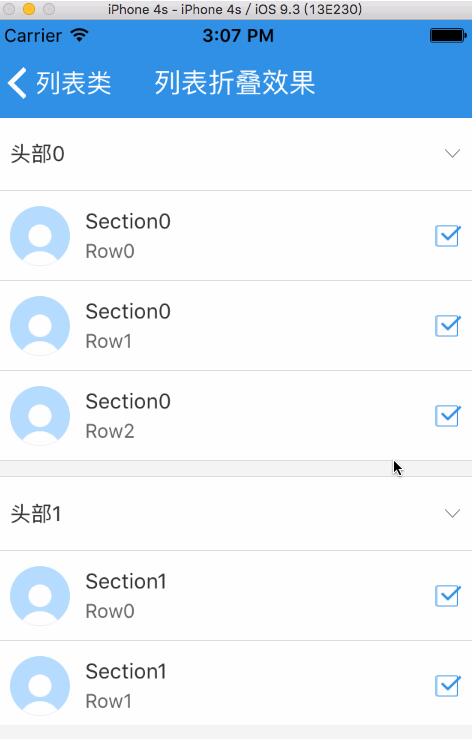本文实例为大家分享了iOS实现列表折叠效果的具体代码,供大家参考,具体内容如下
实现列表折叠效果其实比较简单,点击列表头部的时候,把返回列表行数设为 0,就是收起列表;再次点击列表头部,显示列表的行数,就展开了列表。
#import "TableDownUpVC.h"#import "TableViewCell_TableSelect.h"@interface TableDownUpVC (){ NSMutableDictionary *dicSelet; NSArray *arrData; NSMutableArray *arrStatus; NSInteger selectFlag; NSMutableDictionary *dictShow;}@property (nonatomic, strong) UIImageView *imgArror;@end@implementation TableDownUpVC- (void)viewDidLoad { [super viewDidLoad]; self.tableView.autoresizingMask = UIViewAutoresizingFlexibleHeight; self.title = @"列表折叠效果"; dictShow = [[NSMutableDictionary alloc] init]; arrStatus = [[NSMutableArray alloc] init]; NSDictionary *dict0 = @{@"section":@"头部0", @"content":@[@{@"title":@"Section0",@"subTitle":@"Row0",@"avator":@"user_default_blue"}, @{@"title":@"Section0",@"subTitle":@"Row1",@"avator":@"user_default_blue"}, @{@"title":@"Section0",@"subTitle":@"Row2",@"avator":@"user_default_blue"}]}; NSDictionary *dict1 = @{@"section":@"头部1", @"content":@[@{@"title":@"Section1",@"subTitle":@"Row0",@"avator":@"user_default_blue"}, @{@"title":@"Section1",@"subTitle":@"Row1",@"avator":@"user_default_blue"}, @{@"title":@"Section1",@"subTitle":@"Row2",@"avator":@"user_default_blue"}]}; NSDictionary *dict2 = @{@"section":@"头部2", @"content":@[@{@"title":@"Section2",@"subTitle":@"Row0",@"avator":@"user_default_blue"}, @{@"title":@"Section2",@"subTitle":@"Row1",@"avator":@"user_default_blue"}, @{@"title":@"Section2",@"subTitle":@"Row2",@"avator":@"user_default_blue"}]}; arrData = @[dict0,dict1,dict2]; dicSelet = [[NSMutableDictionary alloc] init]; //初始化选中状态(默认都不选择) for (NSInteger i=0; i<arrData.count; i++) { NSArray *content = arrData[i][@"content"]; NSMutableDictionary *dict = [[NSMutableDictionary alloc] init]; for (NSInteger j=0; j<content.count; j++) { [dict setObject:@"0" forKey:STR_NUM(j)]; } [arrStatus addObject:dict]; } //初始化列表头部折叠状态 for (NSInteger i=0; i<arrData.count; i++) { [dictShow setObject:@"0" forKey:STR_NUM(i)]; }}#pragma mark - TableViewDataSource,UITableViewDelegate 扩展- (NSInteger)numberOfSectionsInTableView:(UITableView *)tableView{ return arrData.count;}- (NSInteger)tableViewEx:(UITableView *)tableView numberOfRowsInSection:(NSInteger)section{ NSString *isShow = dictShow[STR_NUM(section)]; if ([isShow isEqualToString:@"0"]) { NSArray *arr = arrData[section][@"content"]; return arr.count; } else { return 0; }}- (CGFloat)tableViewEx:(UITableView *)tableView heightForRowAtIndexPath:(NSIndexPath *)indexPath{ return 60;}- (UITableViewCell *)tableViewEx:(UITableView *)tableView cellForRowAtIndexPath:(NSIndexPath *)indexPath{ static NSString * identifier = @"cellIdentifier"; TableViewCell_TableSelect *cell = [tableView dequeueReusableCellWithIdentifier:identifier]; cell.selectionStyle = UITableViewCellSelectionStyleNone; if (cell == nil) { cell = [[TableViewCell_TableSelect alloc]initWithStyle:UITableViewCellStyleSubtitle reuseIdentifier:identifier]; } [cell setDictInfo:arrData[indexPath.section][@"content"][indexPath.row]]; [cell setAccessoryImage:arrStatus[indexPath.section][STR_NUM(indexPath.row)]]; return cell;}- (void)tableViewEx:(UITableView *)tableView didSelectRowAtIndexPath:(NSIndexPath *)indexPath{ NSMutableDictionary *dict = arrStatus[indexPath.section]; NSString *str = dict[STR_NUM(indexPath.row)]; if ([str isEqualToString:@"0"]) { [dict setValue:@"1" forKey:STR_NUM(indexPath.row)]; } else { [dict setValue:@"0" forKey:STR_NUM(indexPath.row)]; } [self.tableView reloadData];}- (CGFloat)tableView:(UITableView *)tableView heightForHeaderInSection:(NSInteger)section{ return 50;}- (CGFloat)tableView:(UITableView *)tableView heightForFooterInSection:(NSInteger)section{ return 10;}- (UIView *)tableView:(UITableView *)tableView viewForHeaderInSection:(NSInteger)section{ UIView *headerView = [UICommonCtrl commonViewWithFrame:CGRectMake(0, 0, SCREEN_WIDTH, 50) color:kColor_White]; UILabel *title = [UICommonCtrl commonLabelWithFrame:CGRectMake(10, 15, 200, 20) text:arrData[section][@"section"] color:kColor_Black font:kFont_Large textAlignment:NSTextAlignmentLeft]; [headerView addSubview:title]; _imgArror = [UICommonCtrl commonImageViewWithFrame:CGRectMake(SCREEN_WIDTH-20, 22.5, 10, 5) image:nil]; [headerView addSubview:_imgArror]; NSString *str = [dictShow objectForKey:STR_NUM(section)]; if ([str isEqualToString:@"0"]) { _imgArror.image = [UIImage imageNamed:@"icon_down"]; } else { _imgArror.image = [UIImage imageNamed:@"icon_up"]; } @weakify(self) UIButton *btn = [UICommonCtrl commonButtonWithFrame:CGRectMake(0, 0, SCREEN_WIDTH, 50) text:@"" color:kColor_Black font:kFont_Large backgroundImage:nil block:^(UIButton *btn) { @strongify(self) NSString *str = [dictShow objectForKey:STR_NUM(section)]; if ([str isEqualToString:@"0"]) { [dictShow setValue:@"1" forKey:STR_NUM(section)]; } else { [dictShow setValue:@"0" forKey:STR_NUM(section)]; } [self refreshSection:section]; }]; [headerView addSubview:btn]; for (NSInteger i=0; i<2; i++) { UIView *line = [UICommonCtrl commonLineViewWithFrame:CGRectMake(0, (50-LINE_SIZE)*i, SCREEN_WIDTH, LINE_SIZE) color:kColor_Line]; [headerView addSubview:line]; } return headerView;}- (UIView *)tableView:(UITableView *)tableView viewForFooterInSection:(NSInteger)section{ UIView *footerView = [UICommonCtrl commonViewWithFrame:CGRectMake(0, 0, SCREEN_WIDTH, 10) color:kColor_Background]; return footerView;}- (void)refreshSection:(NSInteger)section{ NSIndexSet *indexSet=[[NSIndexSet alloc]initWithIndex:section]; [self.tableView reloadSections:indexSet withRowAnimation:UITableViewRowAnimationFade];}@end效果图

以上就是本文的全部内容,希望对大家的学习有所帮助,也希望大家多多支持武林网。
新闻热点
疑难解答